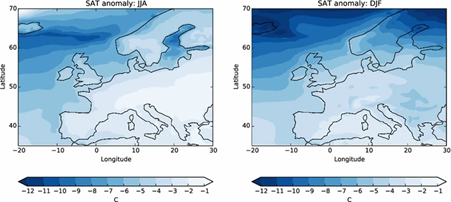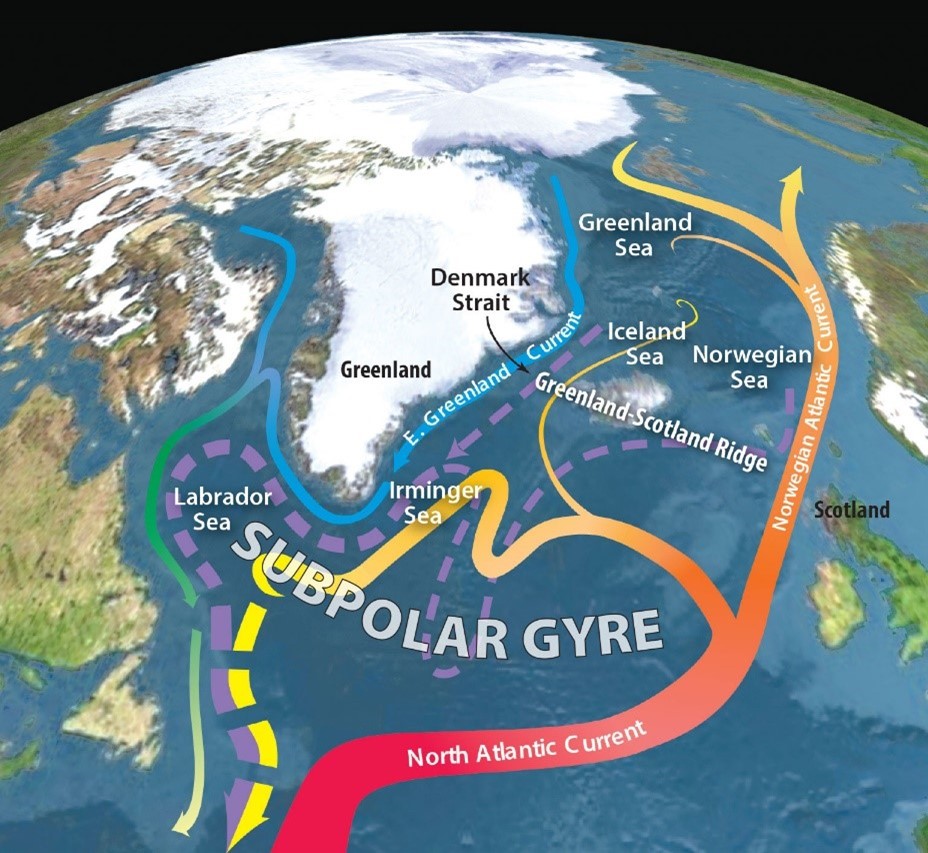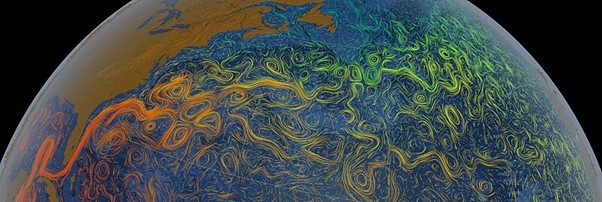The Evolution of the Atlantic Meridional Overturning Circulation (AMOC)
Background
Recent research has shed light on the fate of the Atlantic Meridional Overturning Circulation (AMOC), which plays a significant role in shaping Ireland’s climate. Direct measurements of the AMOC have only been available since 2004. These measurements show strong natural fluctuations and at most a slight decrease in the AMOC’s strength (RAPID). Observations of the flow through the Florida Strait, a main component of the AMOC, are available for about 40 years and show no long-term change in the strength of this current1.
Media coverage of late has highlighted recent studies which suggest that the AMOC could collapse in the next few decades implying a much colder Irish climate than today2,3,4. However, these studies have faced criticism for their simplified methods or reliance on idealized models. Experts note that if a shutdown were to occur, it would likely take several decades or even centuries5 due to the ocean’s slow response.
The AMOC’s future is closely tied to various global changes, including melting of Arctic sea ice6 and Greenland ice7, and even conditions as far away as Antarctica8 and the Indian Ocean9. Climate studies going back in time hundreds of thousands and even millions of years show differing results regarding the AMOC’s stability during different periods, with some suggesting it remained stable despite significant freshwater input from melting ice in the past.
Current climate models predict a slowdown of the AMOC by 34% to 45% by the end of the century, which is expected to reduce the global warming trend around Ireland but not to lead to a cooling (Fig. 1a, c, d, e, f). However, some models do indicate that this slowdown could result in a slight cooling around Ireland (Fig. 1b). The pronounced cooling south of Greenland in Fig. 1b is often referred to as the North Atlantic “warming hole” and linked to a slowdown of the AMOC. In fact, such a cooling is visible in long-term observations of the ocean heat content throughout the uppermost 2000 m (Fig. 2). Nevertheless, the North Atlantic and global sea surface temperatures have reached record highs in 2023 and 2024 (Climate Reanalyzer), indicating that the downward trend in sea surface temperature is overlaid by variability. The reasons behind these record temperatures are still being investigated.

Fig. 1 (reproduced from the technical summary of the Sixth Assessment Report of the Intergovernmental Panel on Climate Change10, their Box TS3, Fig. 1): (a) Coupled Model Intercomparison Project Phase 6 (CMIP6) best estimate early action (low emission) scenario surface temperature change in 2081–2100 relative to 1995–2014, (b) high-warming models early action surface temperature change, and (c) very high-warming models early action surface temperature change. (d–f) Same as (a–c) but for late action (high emission) scenario. Note the different colour bars in (a–c) and (d–f).

Fig. 2 (Image credit: Lijing Cheng, reproduced from Rahmstorf, 202411): Trend in ocean heat content of the upper 2,000 m, 1958–2023
Currently, there are no specific studies focused on how a slowdown or shutdown of the AMOC would impact Ireland’s climate directly. However, studies have been carried out using individual climate models to explore the effects of a strong AMOC decline on Europe12,13. The findings suggest that Ireland could experience a temperature drop of 2 to 4 degrees, particularly in winter, along with drier summers (Fig. 3a, 3b). The west of Ireland might see wetter winters due to stronger storm activity. A more extreme scenario, involving a complete collapse of the AMOC, could lead to severe impacts on agriculture in the UK14. It’s important to note that these studies do not account for the overall trend of global warming, which could offset some of the cooling effects, especially in the summer months. These studies also use relatively coarse global climate models, i.e. with low spatial resolutions.
Another factor to consider is the influence of the aforementioned North Atlantic “warming hole” on Ireland’s climate. Changes in the jet stream and a decrease in westerly storm activity, driven by a reduced temperature difference between the warming Arctic and the moderately warming mid-latitudes, could diminish this impact. For instance, Europe experienced a heat wave in 2015, even with a cold North Atlantic15.

Fig. 3a (reproduced from Jackson et al., 201512): Impact of an AMOC slowdown on the European climate. 2 m temperature change in summer (left) and in winter (right). Anomalies that are not significant compared to the control variability are white.

Fig. 3b (reproduced from Jackson et al., 201512): Impact of an AMOC slowdown on the European climate. Precipitation as a relative or fractional change in summer (left) and in winter (right). Anomalies that are not significant compared to the control variability are white.
The AMOC is complex, involving various ocean currents (Fig. 4) and eddies (Fig. 5) that contribute to the heat transport. Different branches of the AMOC exist in the northern North Atlantic, and their future development is crucial for understanding how Ireland’s climate may change. Recent high-resolution climate simulations under a high-emissions scenario suggest that the eastern branch of the AMOC could strengthen, leading to significant warming in that area16. Understanding these dynamics is essential for predicting future climate conditions in Ireland.

Fig. 4 (modified from R. Curry and C. Mauritzen © Woods Hole Oceanographic Institution, reproduced from Rahmstorf, 202411): Different branches of the ocean circulation in the northern North Atlantic and the Nordic Seas. Solid lines represent surface flows and dashed lines deep ocean flows.

Fig. 5 (Source: NASA/GSFC Scientific Visualization Studio): Ocean eddies based on satellite measurements with colours indicating sea surface temperatures
Met Éireann’s work on Climate Modelling
Recognizing the significance of the AMOC and its effects on Ireland’s climate, Met Éireann is funding and conducting research as part of the Enhanced North Atlantic Climate Simulation (ENACTS) project, collaborating with the Irish Centre for High-End Computing (ICHEC) and engaging in international research partnerships. Advanced methods to better understand narrow ocean currents and to incorporate freshwater inputs from melting ice in Greenland and Antarctica into climate models are being developed.
Given the limited research on the potential effects of an AMOC shutdown on Ireland’s climate, Met Éireann has prioritized several key areas of focus:
- Developing scenarios for a significant decline in the AMOC by the end of the century and examining the related impacts on Ireland’s climate.
- Enhancing the accuracy of AMOC projections by refining climate models.
- Studying how mid-latitude cyclones respond to changes in the jet stream.
In conclusion, while the risk of an AMOC shutdown is low, it would be a low probability/high impact event. The impacts derived from a complete shutdown could have serious consequences on the planet and on Irish society, such as disruption to land and marine ecosystems and biodiversity, and socio-economic pressures related to climate resilience and responses to hazardous weather.
As with every aspect of climate change, we have to work both on mitigation and adaptation. On one hand, with dedicated research we can quantify the risk of different AMOC evolution scenarios and support our adaptation to them, while on the other hand, with global efforts of reducing greenhouse gas emissions, the risks should be mitigated.
Literature
1 Volkov, D. L., R. H. Smith, R. F. Garcia, D. A. Smeed, B. I. Moat, W. E. Johns, and M. O. Baringer (2024): Florida Current transport observations reveal four decades of steady state. Nature communications, 15, 7780. https://doi.org/10.1038/s41467-024-51879-5
2 Ditlevsen, P., and S. Ditlevsen (2023): Warning of a forthcoming collapse of the Atlantic meridional overturning circulation. Nature Communications, 14, 4254. https://doi.org/10.1038/s41467-023-39810-w
3 Van Westen, R. M., M. Kliphuis, and H. A. Dijkstra (2024): Physics-based early warning signal shows that AMOC is on tipping course. Science Advances, 10, 6, https://doi.org/10.1126/sciadv.adk1189
4 Lohmann, J., H. A. Dijkstra, M. Jochum, V. Lucarini, and P. D. Ditlevsen (2024): Multistability and intermediate tipping of the Atlantic Ocean circulation. Science Advances, 10, 12. https://doi.org/10.1126/sciadv.adi2453
5 Liu, W., S.-P. Xie, Z. Liu, and J. Zhu (2017): Overlooked possibility of a collapsed Atlantic Meridional Overturning Circulation in warming climate. Sci. Adv. 3, e1601666. https://doi.org/10.1126/sciadv.1601666
6 Haine, T. W., Siddiqui, A. H., & Jiang, W. (2023). Arctic freshwater impact on the Atlantic Meridional Overturning Circulation: status and prospects. Philosophical Transactions of the Royal Society A, 381(2262), 20220185. https://doi.org/10.1098/rsta.2022.0185
7 Devilliers, M., Yang, S., Drews, A. et al. (2024): Ocean response to a century of observation-based freshwater forcing around Greenland in EC-Earth3. Clim Dyn 62, 4905–4923. https://doi.org/10.1007/s00382-024-07142-0
8 An, SI., Moon, JY., Dijkstra, H.A. et al. (2024): Antarctic meltwater reduces the Atlantic meridional overturning circulation through oceanic freshwater transport and atmospheric teleconnections. Commun Earth Environ 5, 490. https://doi.org/10.1038/s43247-024-01670-7
9 Hu, S., and A. V. Fedorov (2019): Indian Ocean warming can strengthen the Atlantic meridional overturning circulation. Nature climate change 9.10, 747-751. https://doi.org/10.1038/s41558-019-0566-x
10 IPCC (2021): Technical Summary. In Climate Change 2021: The Physical Science Basis. Contribution of Working Group I to the Sixth Assessment Report of the Intergovernmental Panel on Climate Change [Masson-Delmotte, V., P. Zhai, A. Pirani, S.L. Connors, C. Péan, S. Berger, N. Caud, Y. Chen, L. Goldfarb, M.I. Gomis, M. Huang, K. Leitzell, E. Lonnoy, J.B.R. Matthews, T.K. Maycock, T. Waterfield, O. Yelekçi, R. Yu, and B. Zhou (eds.)]. Cambridge University Press, Cambridge, United Kingdom and New York, NY, USA, pp. 33−144. doi: 10.1017/9781009157896.002
11 Rahmstorf, S. (2024): Is the Atlantic Overturning Circulation Approaching a Tipping Point? Oceanography, 37, 3, 16-29. https://doi.org/10.5670/oceanog.2024.501
12 Jackson, L.C., Kahana, R., Graham, T. et al. (2015): Global and European climate impacts of a slowdown of the AMOC in a high resolution GCM. Clim Dyn 45, 3299–3316. https://doi.org/10.1007/s00382-015-2540-2
13 Bellomo, K., Meccia, V.L., D’Agostino, R. et al. (2023): Impacts of a weakened AMOC on precipitation over the Euro-Atlantic region in the EC-Earth3 climate model. Clim Dyn 61, 3397–3416. https://doi.org/10.1007/s00382-023-06754-2
14 Ritchie, P. D. L., G. S. Smith, K. J. Davis, C. Fezzi, S. Halleck-Vega, A. B. Harper, C. A. Boulton, A. R. Binner, B. H. Day, A. V. Gallego-Sala, J. V. Mecking, S. A. Sitch, T. M. Lenton, and I. J. Bateman (2020): Shifts in national land use and food production in Great Britain after a climate tipping point. Nature Food, 1, 76-83. https://doi.org/10.1038/s43016-019-0011-3
15 Duchez, A., E. Frajka-Williams, S. A. Josey, D. G. Evans, J. P. Grist, R. Marsh, G. D. McCarthy, B. Sinha, D. I. Berry, and J. J.-M. Hirschi (2016): Drivers of exceptionally cold North Atlantic Ocean temperatures and their link to the 2015 European heat wave. Environmental Research Letters, 11, 074004. https://doi.org/10.1088/1748-9326/11/7/074004
16 Arthun, M., H. Asbjornsen, L. Chafik, H. L. Johnson, and K Vage (2023): Future strengthening of the Nordic Seas overturning circulation. Nature Communications, 14, 2065. https://doi.org/10.1038/s41467-023-37846-6